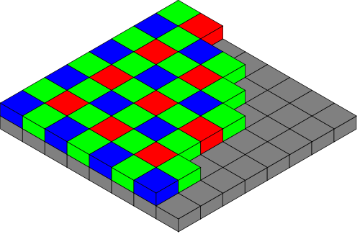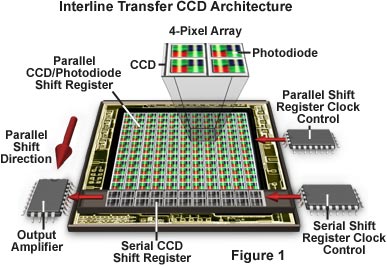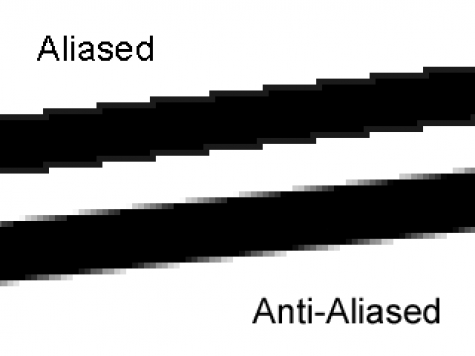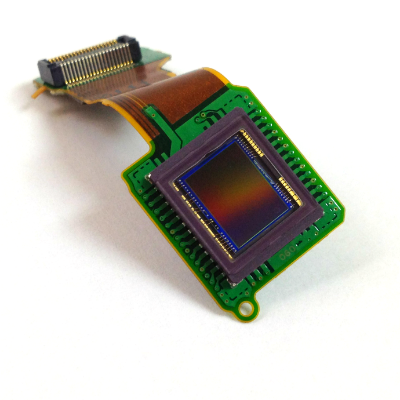There are two image sensor types used today, CCD (Charge Coupled Device) and CMOS (Complementary Metal Oxide Semiconductor). CCD sensors are widely used in almost all compact cameras; however, CMOS has largely replaced them in the professional level products. Both operate in a similar fashion utilizing the photoelectric effect that occurs when photons (light) interact with crystallized silicon creating an electric charge. If they both function similarly, then what is the difference? Keep reading to find out.

Bayer Pattern
The crystallized silicon that interacts with light is designed in such a way that millions of individual segments are linked together in a grid; the individual segments are called pixels. A color filter array, most commonly a “Bayer filter†(pictured), covers each of the millions of pixels. This filter uses individual red, green, and blue elements in order to sort the three primary colors used to create digital images. When looking at a sensor you will notice that as you tilt it, the color changes from a purple-ish to a green hue; this is the effect of the filter array.

On top of the sensor is a filter referred to as either a “low pass†or “anti-aliasing†filter. It is the outermost part of the sensor and it is the portion exposed on a DSLR when lenses are interchanged. This filter is generally made of glass with a number of coatings and is somewhat resistant to scratching. If you’ve ever noticed dark spots that appear in the same place on your images and have a professional cleaning of this filter will usually solve the problem. The anti-aliasing coating prevents the affects of aliasing, no shock there, and smoothes the “jaggedness†of the image (see example) . It also has special coatings to filter out other spectrums of light, like ultraviolet and infrared, that are visible to the sensor but not by the human eye. It is possible to remove and replace this filter with other filters to change which spectrums the camera is sensitive to, but is generally costly and renders your camera useless for anything but that kind of specialty photography. Warning: it is not recommended that you attempt this as your next weekend project; leave it to the professionals!
. It also has special coatings to filter out other spectrums of light, like ultraviolet and infrared, that are visible to the sensor but not by the human eye. It is possible to remove and replace this filter with other filters to change which spectrums the camera is sensitive to, but is generally costly and renders your camera useless for anything but that kind of specialty photography. Warning: it is not recommended that you attempt this as your next weekend project; leave it to the professionals!
So what is the major difference between CMOS and CCD design? It is all in how the charge on the silicon is transferred and processed into an image.
A CCD sensor holds the charge at each pixel after light strikes it through the corresponding color filter. The charge is then shifted in rows much like a bucket brigade, and is then processed through additional circuitry into the image that you see. CCD technology has long been the staple used in camera imaging because of the CMOS design limitations. CCD sensors are known for superior image quality with better noise control; however, they are susceptible to image blooming whereas CMOS sensors are not. CCD sensors are also much less costly to fabricate than CMOS.
In contrast, a CMOS sensor (also known as an active pixel sensor) collects the charge through the use of circuitry at each individual pixel and then directly processes it into an image. Processing is much faster than a CCD sensor and uses less power. Recently CMOS construction has improved to match the CCD standard, allowing for more functionality, lower power requirements, and high speed image capture. This technology is more suitable for cameras where burst shooting is required; however, CMOS sensors used in conjunction with “rolling shutters†(think video) can cause image skew, wobble, or partial exposure where CCD sensors are immune to those effects.
Like all matters in life, there are pros and cons to choosing one item over another. Which camera you choose to use based on the sensor capabilities is up to you.

{ 1 comment… read it below or add one }
This is very helpful in understanding the functionality of the technical components.
[WORDPRESS HASHCASH] The poster sent us ‘0 which is not a hashcash value.